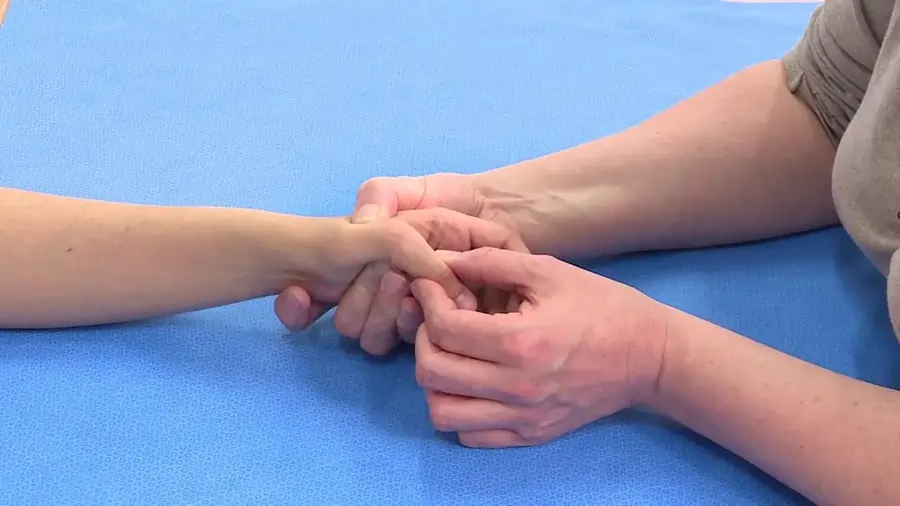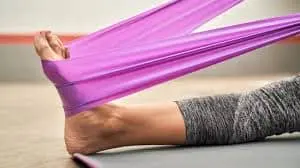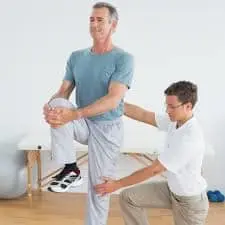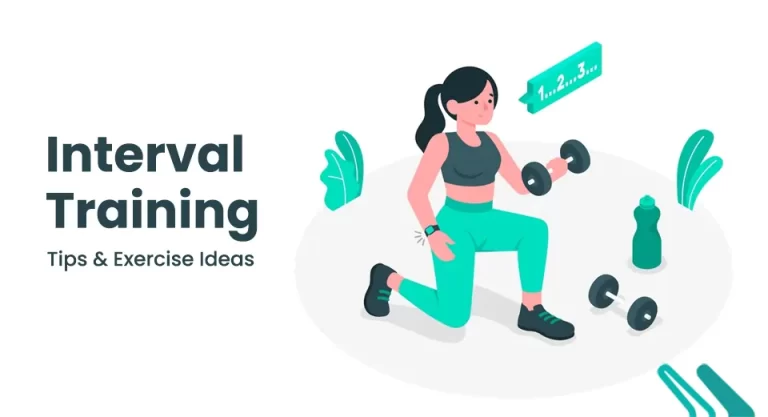14 Best Exercises For Radial Collateral Ligament Injury
Introduction:
The elbow (lateral elbow RCL) or thumb (thumb RCL) are the most common locations for radial collateral ligament (RCL) injuries, which can significantly impact everyday function, strength, and mobility. The radial collateral ligament’s function is to stabilize the elbow against inner-to-outer stress. The radial collateral ligament can be repaired by physical therapy, medicine, rest, and splinting when it has been pulled or strained.
The most frequent reason for radial collateral ligament injury or damage is a fall into an outstretched hand. As the individual tries to catch himself, one of the three ligaments in the joint, including the Radial Collateral Ligament, because of the extreme strain that this type of fall puts on the elbow, it may extend or rupture.
Non-operative treatment is the first line of defense for fixing a radial collateral Ligament injury. If there is a tear in the ligament or if the elbow was dislocated during the incident, surgery may be required. The recovery process depends on proper rehabilitation Exercises For Radial Collateral Ligament Injury, regardless of whether the injury occurred due to trauma, repeated stress, or sports-related activities.
Physical therapy can assist in relieving tension on the Radial Collateral Ligament by strengthening the muscles surrounding the elbow and restoring its strength and range of motion.
Causes:
Less Common Degenerative Changes
- Over time, the ligament can break down in older persons or those with severe joint degeneration.
- Connected to the degeneration of joints or arthritis.
- It may happen in conjunction with other soft tissue injuries.
Traumatic Damage
- Trauma is the most obvious and direct cause of Radial Collateral Ligament (RCL) damage, often including high-impact forces that result in the ligament’s tension or rupture.
- Thumb’s radial collateral ligament (RCL), although injuries to the ulnar collateral ligament (UCL) are more frequent.
- A fall onto an outstretched hand (FOOSH), especially when the forearm is supinated and the elbow is partially flexed.
Joint instability or ligament flexibility
- Some people are more vulnerable to damage, even from little forces, due to naturally looser ligaments (ligamentous laxity).
- It might be linked to genetic conditions (like Ehlers-Danlos syndrome).
- A sequence of minor injuries may eventually lead to ligament breakdown.
Overuse or Repetitive Stress
- This is the term for persistent ligament overload caused by repetitive activity, particularly in manual laborers and sports.
- Frequent in occupations or activities requiring repeated forearm rotation (pronation/supination) and elbow extension.
- These motions damage the ligament over time by creating tiny tears that eventually result in partial tears.
Ineffective Technique or Biomechanics
- When playing sports or engaging in repeated activities, improper form can put excessive stress on the Radial Collateral Ligament.
- Poor mechanics of throwing.
- Weak supporting muscles (shoulder stabilizers, wrist extensors, etc.).
- Weak workplace ergonomics, particularly when it comes to repetitive arm motions or heavy lifting.
Signs and symptoms:
Although pain and instability are common symptoms of radial collateral ligament (RCL) injuries, the exact symptoms might differ depending on the injury’s location, degree, and stage.
Pain
- Pain that limits movement to the radial (thumb-side) and lateral (outside) sides of the metacarpophalangeal (MCP) joints.
- Activities that require pressing, rotating the forearm, or bearing weight through the arm make the pain worse.
- Makes the thumb more painful to grab, squeeze, or stretch.
Joint instability
- A sensation of the joint being loose, unstable, or ready to “give out”
- When engaging in an activity, the elbow joint may feel uncomfortable.
- The thumb may move abnormally while grasping or squeezing firmly.
Discoloration or bruising
- The appearance of e or bruises surrounding the torn ligament may be signs of bleeding or rupture in acute injuries.
Weakness
- A thumb grip weakness.
- Decreased elbow pressing strength.
- May refrain from using the limb because it is unstable or uncomfortable.
Reduced Range of Motion
- At the painful joint, pain may limit normal flexion, extension, or rotation.
- Difficulty abducting or completely extending the thumb.
- Restriction in pronation/supination or complete extension.
Clicking or Sensation Catching (Severe/Chronic Cases)
- Little joint instability that might cause a clicking sound while pushing off a surface or turning the forearm.
- Particularly when switching from a pinch to an open-hand position, clicking while moving the thumb.
Tenderness and Swelling
- Swelling at the elbow’s lateral side.
- It is touch-sensitive about or slightly above the lateral epicondyle.
- Sensitivity on the thumb base’s radial side.
Benefits of exercise:
For a safe and efficient rehabilitation from a Radial Collateral Ligament (RCL) injury, which usually affects the elbow or thumb, exercise is essential.
Improves Neuromuscular Control
- Exercise improves coordination and proprioception (joint awareness), two abilities that are frequently compromised after an injury.
- By doing this, uncomfortable motions that can cause the ligament to re-injure are avoided.
Minimises Swelling and Pain
- Movement promotes lymphatic drainage and blood flow, both of which reduce inflammation.
- Endorphins, which are naturally occurring painkillers, are released during specific exercises.
Improves Range of Motion
- Mobility exercises and gentle, gradual stretching help in the restoration of a full joint range of motion.
Encourages the Healing of Ligaments
- Over time, ligament strength and structure are improved by collagen remodeling, which is encouraged by controlled mechanical stress from exercise.
Builds Up Supporting Muscles
- The forearm, wrist, and hand muscles are the target of strengthening workouts in order to stabilize the joint.
- Strong muscles prevent re-injury by reducing the load on the healing ligament.
Restores Useful Function
- Exercises for a gradual return to function resemble everyday jobs and sports-specific duties.
- Increases confidence and gets the person ready to safely resume their regular activities.
Avoids Complications
- Without exercise, prolonged immobility can result in joint stiffness, muscular atrophy, and even chronic pain.
- Exercise prevents these side effects and encourages a well-rounded recovery.
Before starting an exercise program, take these precautions:
Before starting any exercise program, it’s crucial to consider a few safety measures to guarantee your well-being and maximize the advantages. Consult your physician or physical therapist to determine which exercises are most suitable to treat your specific problem.
You should listen to your body and avoid pushing yourself above your limits. Exercise often causes mild pain, but if the pain gets worse or gets worse, it can be an indication that you’re pushing yourself too hard. Start with low-impact exercises to gradually progress to more difficult ones once you can handle more pain.
Get guidance from a qualified professional if you’re unsure about how to perform an exercise routine. Warm up before beginning any activity to better prepare your joints and muscles for the workout.
Exercises For Radial Collateral Ligament Injury:
Wrist circles
- Place your arms palms down in front of you.
- Make a slow circle with your wrists.
- Make 5 to 15 clockwise rotations.
- Make five to fifteen anticlockwise rotations after turning around.
- Then return to your neutral position.
- Then relax.
- Repeat these exercises 5 to 10 times.
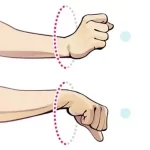
Wrist turn
- Step one is to stand on the floor.
- Next, extend your hand and straight your elbow.
- With the palm pointing up and little to no weight on it.
- As you carefully rotate your wrist, keep your palm down.
- Hold this position for a few seconds.
- Then return to your neutral position.
- Then relax.
- Repeat these exercises 5 to 10 times.
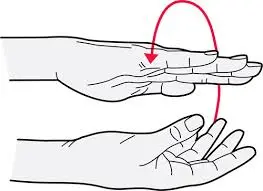
Elbow band
- Find a place that allows you to stand comfortably.
- Breathe deeply.
- Raise your arm and slowly bend it.
- Hold this position for a few seconds.
- Lower your arm.
- Then return to your neutral position.
- Then relax.
- Repeat these exercises 5 to 10 times.
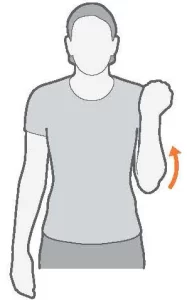
Ball squeezes
- To begin, grasp a tennis ball in your hand and form a fist with your fingers.
- For a little while, keep it tightly in your grasp.
- Next up is the squeeze ball.
- Hold this position for a few seconds.
- Then return to your neutral position.
- Then relax.
- Repeat these exercises 5 to 10 times.
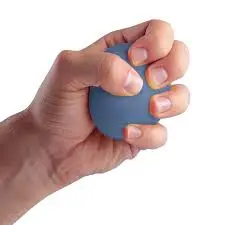
Isometric Biceps Exercises
- Sit down at the table to start.
- Raise the forearm of your working arm until it is roughly parallel to your body.
- Your resting arm should be placed around the working arm’s wrist.
- Use your off arm to resist the action as you attempt to curl your working arm upward.
- Hold this position for a few seconds. Do not slouch your upper back.
- Pull your shoulder blades gently together to provide a firm base from which your arms may pull.
- Then return to your neutral position.
- Then relax.
- Repeat these exercises 5 to 10 times.

Fist exercise
- Start by holding your hands out and extending your fingers.
- Make a fist out of your fingers with caution.
- Squeeze for a few seconds.
- Hold this position for a few seconds.
- Then return to your neutral position.
- Then relax.
- Repeat these exercises 5 to 10 times.
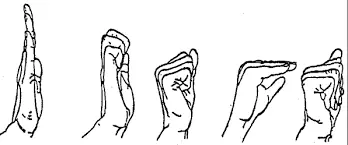
Thumb flexion
- To begin, hold your left hand out straight with all of your fingers.
- Flex your hand such that the palm is toward your thumb.
- Press down with your thumb on the little fingertip.
- Not being able to reach your little finger shouldn’t worry you.
- Simply put, reach out as far as your thumb will allow.
- Hold this position for a few seconds.
- Then return to your neutral position.
- Then relax.
- Repeat these exercises 5 to 10 times.

Wrist Side-to-Side (Radial and Ulnar Deviation)
- Place your arm, palm down, in front of you.
- Slowly move your wrist from side to side, first clearly towards your pinky.
- Next, then radially towards your thumb.
- Your forearm should not move; just your wrist should.
- Perform five to ten reps in each direction.
- Then return to your neutral position.
- Then relax.
- Repeat these exercises 5 to 10 times.
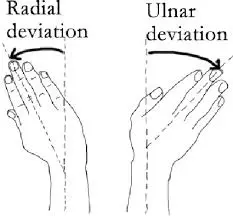
Towel Twist
- Using one hand, hold both ends of a loosely rolled towel by its length.
- Maintain a comfortable posture.
- You can use your hands to twist the towel in different ways, just like you would to remove water.
- For a few seconds, keep going like this.
- Then return to your neutral position.
- Then relax.
- Repeat these exercises 5 to 10 times.
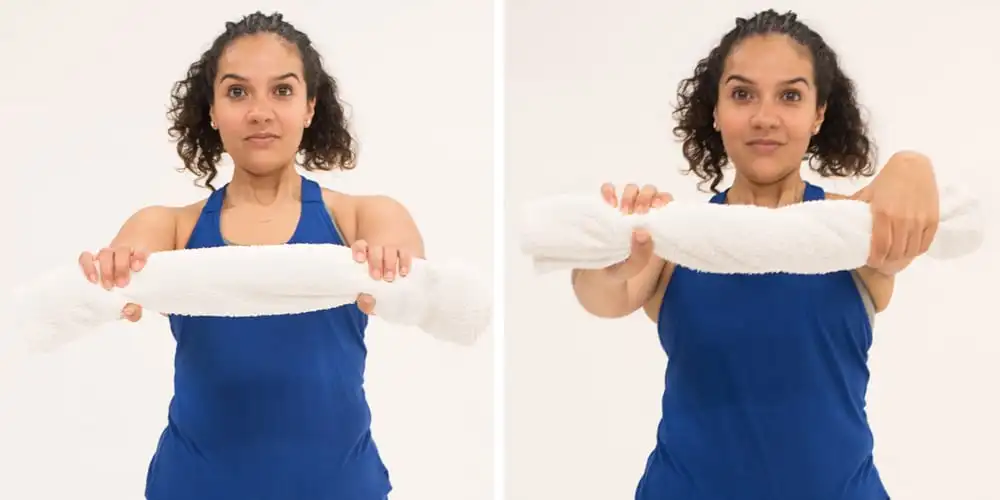
Finger Stretch
- Put a hand down on a table.
- To keep your hand secure, put a rubber band around the base of your finger joints.
- Slowly separate your thumb from your fingers as much as you can.
- Hold this position for a few seconds.
- Then return to your neutral position.
- Then relax.
- Repeat these exercises 5 to 10 times.
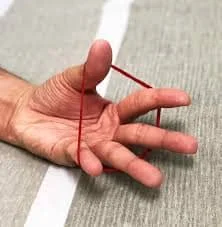
Forearm Supination and Pronation
- Get into a standing position first.
- Hold your arm close to you.
- Then bend your elbow.
- Rotate your forearm and wrist so that your palm is facing down.
- Hold this position for a few seconds.
- Next, rotate your wrist and forearm in the other direction, palm up.
- Hold this position for a few seconds.
- Then return to your neutral position.
- Then relax.
- Repeat these exercises 5 to 10 times.

Finger Spreading Exercise
- To start, settle into a comfortable chair.
- Make your fingers straight.
- With your thumb facing your palm, take this position.
- Hold this position for a few seconds.
- Then return to your neutral position.
- Then relax.
- Repeat these exercises 5 to 10 times.
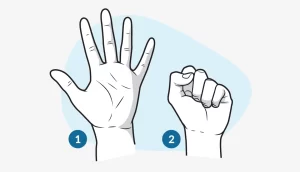
Wrist flexion with Light Resistance
- You will need to sit in a chair to complete this workout.
- After that, rest your elbow on the table.
- In your hand, hold a 2-pound dumbbell upright.
- Bend your wrist by extending it within your body with your palm pointing up.
- Hold this position for a few seconds.
- Then return to your neutral position.
- Then relax.
- Repeat these exercises 5 to 10 times.
- If you find this exercise too difficult, try it without any weight.
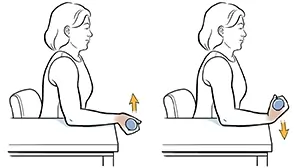
Wrist Extension with Light Resistance
- You must sit in a chair to complete this exercise.
- Place your elbow on the table.
- Next, hold a two-pound dumbbell straight in your hand.
- You can straighten your wrist by bending it away from your body and pointing it down.
- Hold this position for a few seconds.
- Then return to your neutral position.
- Then relax.
- Repeat these exercises 5 to 10 times.
- Don’t use any weight if you find this workout too difficult.
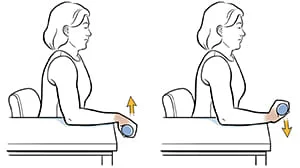
What precautions should be taken when working out?
Exercises for a Radial Collateral Ligament (RCL) injury must be done safely to prevent worsening the condition or causing more harm. Whether the damage is to the thumb or the elbow, taking the right measures will speed up healing and avoid complications.
Get Advice from a Medical Professional First
- Before starting any strengthening or rehabilitation program, make sure the exercises are suitable for your stage of recovery by following the advice of an orthopedic physician or a physical therapist.
- Exercises should be specific to the location and degree of your problem (thumb or elbow).
Make Use of the Right Support When Working Out
- Support the joint using kinesiology tape, braces, or splints.
- This encourages proper positioning and lessens strain on the repairing ligament.
Warming Up and Cooling Off
- Warm up lightly before each session to get the joint and surrounding muscles ready.
- To increase circulation and lessen stiffness, finish with cool-down stretches.
Put Form Above Speed.
- Make sure you position yourself correctly and move slowly and carefully.
- Stay away from quick or jerky movements since they increase ligament tension.
Track Any Indications of Reinjury or Overuse
Give up exercising and consult a specialist if you observe:
- An increase in joint warmth or edema
- Pain that persists after working out
- Stability issues, locking, or clicking
Stay away from painful movements.
- Exercise should be stopped immediately if it causes serious or ongoing pain.
- Sharp, pinching, or pulling pain is a sign of overloading or poor technique, but slight pain is acceptable.
Make Slow Progress Over Resistance
- When resistance is added, use a light band or a weight of 0.5 to 1 pound as your starting resistance.
- Only make progress when you can do the exercise with complete control, pain-free, and with the right form.
- Before increasing resistance, increase repetitions.
Remain Calm and Avoid Being Loud
- Intense, infrequent workouts are less beneficial than short, everyday sessions (10–20 minutes).
- Stick to a prescribed treatment plan. Chronic issues might result from early overloading or stage skipping.
When did you stop working out?
Stopping or changing your exercise plan is necessary to avoid making the injury worse or delaying its healing.
The following lists the main physical indicators, symptoms, and situations in which you should stop or pause Radial Collateral Ligament (RCL) Injury rehabilitation exercises.
Severe or Unexpected Pain While Exercising
- Stop doing an activity right away if you get sudden, intense pain that feels like something sharp.
- This can suggest that the ligament is under too much tension or that the tear is getting deeper.
After an Activity, Swelling
- Early on, little swelling is normal, but if it becomes considerably worse after working out, returns after it has diminished, or is accompanied by redness or warmth, your body could be responding to overuse or reinjury.
- Only resume under supervision and once the swelling has decreased.
Range of Motion (ROM) Loss
If, after exercising, you unexpectedly:
- The elbow and thumb cannot be completely bent or straightened.
- Feel as though the joint is locked or tight.
- The ligament or surrounding tissue has probably been overstressed.
- With exercise, Mobility should progressively become better.
Radiating Pain, Numbness, or Tingling
Stop right away if you experience:
- Numbness in the fingers or forearm
- Pain radiating outside of the injured location.
Form-Affected Muscle Cramping or Fatigue
If the muscles around the joint are overly worn out:
- You’ll probably use poor mechanics to make up for it.
- This may increase the strain on other parts and worsen the damage.
- When you are unable to keep your form, control, or complete movement quality, stop.
“Giving Way” or Joint Instability
- Your elbow or thumb may feel “unstable,” loose, or prone to dislocation when you’re moving.
- Give up working out and speak with your physician or therapist.
- If it’s new or becoming worse, this might be a sign of a partial or full tear.
Not Making Any Progress After Several Weeks
- After weeks of consistency, if your strength, stability, or pain remains the same.
Which exercises should not be performed if you have a radial collateral ligament injury?
To stop additional harm and encourage healing, a radial collateral ligament (RCL) injury, which frequently affects the thumb or elbow, needs to be carefully managed.
The exercises you should avoid will vary depending on how bad your injury is and how far along you are in your recovery, but in general, you should avoid doing anything that puts strain on your joints or hurts.
- Thumb excessive extension: Thumb hyperextension can also put stress on the ligament.
- Elbow Extension with Resistance: Directly stresses the elbow’s stabilizers, such as the radial collateral ligament.
- Particularly in the early phases, excessive or severe supination stretching includes rotating the forearm palm up.
- Planks and Push-Ups: During both exercises, the elbow experiences compression and bending forces.
- Movements in Throwing or Racket Sports: High-velocity movements involving the elbow are used in sports like baseball, tennis, and javelin throwing.
- Heavy gripping: Even while some light grabbing could be a part of therapy, avoid utilizing forceful or aggressive holding that strains the thumb.
- Overhead pressing or heavy lifting: These actions cause lateral elbow joint stress, which puts strain on the injured ligament.
Prevention:
A mix of good mechanics, strength, mobility, and lifestyle choices is necessary for prevention.
Here is a thorough instruction:
Warm Up and Cool Down
- Before beginning an activity, perform dynamic stretches (e.g., arm swings, wrist circles).
- To cool down, use static stretches and mild exercise afterward.
- Makes soft tissue ready for effort and encourages post-activity recuperation.
Recovery & Lifestyle
- Ensure that you have proper food, water, and rest.
- Rest days are crucial for tissue restoration, so don’t skip them.
Preserving Flexibility and Joint Mobility
- Maintain the thumb, elbow, and wrist joints’ range of motion by stretching frequently.
- Greater flexibility facilitates better weight distribution and better joint action.
Building Up Supporting Muscles
- Elbow RCL: Build up your shoulder stabilizers, triceps, and forearm extensors.
- Thumb RCL: Develop grip strength, wrist stabilizers, and thenar muscles.
Wearing Safety Equipment
For manual laborers or athletes:
- Make use of grip supports, wrist/thumb protectors, or taping methods.
- To lessen awkward strain on the hands and elbows, use ergonomically built tools.
- Protection lessens the impact of outside forces and avoids unexpected trauma.
Improving Coordination and Proprioception
- Training in the sense of balance lowers the chance of jerky, sudden movements that could cause ligament damage.
Preventing Repetitive Stress and Overuse
- Take frequent breaks.
- Recognize the early signs of overuse, such as soreness, edema, persistent pain, or a loss of grip strength.
- Allows ligaments time to adjust and heal.
Suitable Methods for Daily Tasks and Sports
- Use proper form and refrain from overextending or over-gripping your thumb or elbow.
- For better, the mechanics of motion get physical therapy evaluations or professional coaching.
- Radial Collateral Ligament overstretching is avoided with proper mechanics.
Avoid Taking Chances or Using Unexpected Force
- Using bent wrists to lift large objects
- Reaching out and catching falls
- Situations involving high impact without bracing (in sports)
Summary:
The ligament that stabilizes the elbow joint by joining the humerus and radius bones is called the radial collateral ligament (RCL).
A systematic workout regimen that changes as the healing process progresses is necessary for rehabilitation after radial collateral ligament damage. For successful rehabilitation, it is important to prioritize joint stability, strength restoration, and controlled mobility.
Physical therapy is often used to improve elbow strength and mobility after a period of rest, ice, compression, and elevation (RICE) to alleviate pain and inflammation from a radial collateral ligament sprain.
With early intervention and preventative measures, the majority of people can regain full strength and mobility, lowering the risk of long-term effects and ensuring a return to sports or other regular activities.
FAQ:
How does a radial collateral ligament (RCL) injury manifest itself?
On the radial (thumb) side of the body, the radial collateral ligament is one ligament that helps in joint stabilization.
Elbow RCL: Provides stability to the lateral elbow.
Thumb RCL: Supports the thumb’s MCP joint on its radial side.
If I have an injury to my radial collateral ligament, can I still exercise?
Yes, but only with targeted supervised recovery activities. A healthcare provider should supervise these workouts, particularly in the early stages.
Which workouts are safe to perform following a radial collateral ligament injury?
Depending on the stage of the injury, Acute Phase: Ice, rest, and mild passive movement. Subacute Phase: mild range-of-motion exercises and isometric activities. Phase of Strengthening: Proprioception training, grip exercises, and resistance bands
When should I start exercising after my radial collateral ligament injury?
Mild sprain: If swelling is gone, rest for three to seven days.
Severe to moderate injuries: typically two to three weeks after the injury or as recommended by a doctor.
How frequently should I work out to help in my recuperation?
Begin with one or two sessions each day, lasting ten to twenty minutes each. Under supervision, the frequency can rise as permitted. Remain away from overtraining; recovery requires rest days.
When can I resume working or playing sports?
The return is contingent upon:
Complete range of mobility without pain
Strength and stability were restored.
Permission from a healthcare professional
During Radial Collateral Ligament (RCL) injury recovery, what should I stay away from?
High-impact sports (e.g., carrying heavy objects, playing tennis) excessively stretch the damaged ligament.
Quick motions.
Taking hold of or pushing beyond resistance too soon.
When I’m recovering, should I use ice or heat?
For the first 48 to 72 hours, ice is the greatest option for reducing pain and swelling. Before exercising, heat can be used to increase blood flow and flexibility.
Can damage to the Radial Collateral Ligament (RCL) heal without surgery?
Rest and rehabilitation are generally effective in healing mild to severe sprains.
Surgery may be necessary for complete tears or persistent instability.
To guarantee complete recovery, rehabilitation is still crucial both before and following surgery.
How should one treat an elbow injury caused by a damaged radial collateral ligament?
If the elbow was dislocated during the incident or if the ligament has burst, surgery may be required. An injury to the radial collateral ligament that was pulled or strained can usually be repaired with rest, bracing, medicine, and physical therapy.
References:
- C. Noel, n.d. The Protocol of Dr. Using Curtis Noel to Repair the Elbow Radial Collateral Ligament. Elbow radial collateral ligament repair.pdf https://www.curtisnoelmd.com/pdf
- B. N. Chua (n.d.). Physiotherapy for tears or strains in the elbow’s lateral collateral ligament. https://phoenixrehabgroup.com/articles/hand-therapy/tear-strain-physiotherapy/elbow-lateral-collateral-ligament
- R., MD. Williams, July 25, 2022. the radial collateral ligament (RCL) or the lateral collateral ligamentcollateral ligament (LCL). Paediatrician Riley J. Williams III, MD. New York City, New York: https://rileywilliamsmd.com/radial-latteral-collateral-ligament-tear-rcl-lcl-orthopedic-elbow-specialist/
- Exercise for a collateral ligament injury: The Climbing Doctor. Nov. 19, 2022. The Climbing Physician. This is https://theclimbingdoctor.com/portfolio-items/collateral-ligament-sprain-4/?srsltid=AfmBOooyYjc2MF-rWk9C0NIhNK5Lv36GD2r_SAxVYIwFd4zyZyxqAJ87
- April 25, 2025, DMediaWeb. Improve your injured elbow with these seven physical therapy exercises. Fort Worth Hand Centre. Exercises for Physical Therapy for Injured Elbows: https://fortworthhandcenter.com/orthopedic
- April 1, 2025: Upswing Health. How do you manage injuries to the lateral (radial) collateral ligaments? Visit https://upswinghealth.com. Elbow lateral ligament injuries https://upswinghealth.com/conditions/radial ligament injuries
- Good, K. February 5, 2025. Katie E. Good lists the top ten elbow sprain exercises for recovering from an elbow injury. Katie E. Good. Exercises to Treat Elbow Sprains: https://katieegood.com/
- S. Physio (n.d.-d). Surrey Physio’s Top 5 Exercises for Elbow Pain. The Surrey Physio. https://www.surreyphysio.co.uk/top-5/top-5-exercises-for-elbow-1
- Isoosi. 24 March 2022. Ten ways to prevent injuries to the elbow ligament. Physical therapy for Twin Boro. .html https://twinboro.com/elbow-ligament-injury
- Image 13, Flexion (Strength) of the wrist. (n.d). The Health System of Saint Luke. Health Library: https://www.saintlukeskc.org/wrist-flexion-strength

